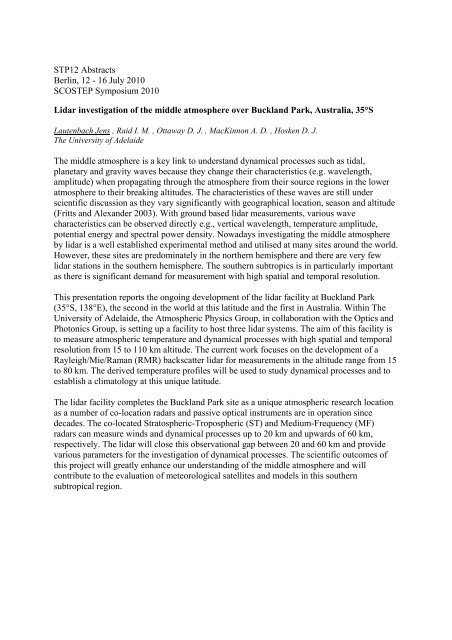scostep 2010 (stp12) - Leibniz-Institut für Atmosphärenphysik an der ...
scostep 2010 (stp12) - Leibniz-Institut für Atmosphärenphysik an der ...
scostep 2010 (stp12) - Leibniz-Institut für Atmosphärenphysik an der ...
You also want an ePaper? Increase the reach of your titles
YUMPU automatically turns print PDFs into web optimized ePapers that Google loves.
STP12 Abstracts<br />
Berlin, 12 - 16 July <strong>2010</strong><br />
SCOSTEP Symposium <strong>2010</strong><br />
Lidar investigation of the middle atmosphere over Buckl<strong>an</strong>d Park, Australia, 35°S<br />
Lautenbach Jens , Raid I. M. , Ottaway D. J. , MacKinnon A. D. , Hosken D. J.<br />
The University of Adelaide<br />
The middle atmosphere is a key link to un<strong>der</strong>st<strong>an</strong>d dynamical processes such as tidal,<br />
pl<strong>an</strong>etary <strong>an</strong>d gravity waves because they ch<strong>an</strong>ge their characteristics (e.g. wavelength,<br />
amplitude) when propagating through the atmosphere from their source regions in the lower<br />
atmosphere to their breaking altitudes. The characteristics of these waves are still un<strong>der</strong><br />
scientific discussion as they vary signific<strong>an</strong>tly with geographical location, season <strong>an</strong>d altitude<br />
(Fritts <strong>an</strong>d Alex<strong>an</strong><strong>der</strong> 2003). With ground based lidar measurements, various wave<br />
characteristics c<strong>an</strong> be observed directly e.g., vertical wavelength, temperature amplitude,<br />
potential energy <strong>an</strong>d spectral power density. Nowadays investigating the middle atmosphere<br />
by lidar is a well established experimental method <strong>an</strong>d utilised at m<strong>an</strong>y sites around the world.<br />
However, these sites are predominately in the northern hemisphere <strong>an</strong>d there are very few<br />
lidar stations in the southern hemisphere. The southern subtropics is in particularly import<strong>an</strong>t<br />
as there is signific<strong>an</strong>t dem<strong>an</strong>d for measurement with high spatial <strong>an</strong>d temporal resolution.<br />
This presentation reports the ongoing development of the lidar facility at Buckl<strong>an</strong>d Park<br />
(35°S, 138°E), the second in the world at this latitude <strong>an</strong>d the first in Australia. Within The<br />
University of Adelaide, the Atmospheric Physics Group, in collaboration with the Optics <strong>an</strong>d<br />
Photonics Group, is setting up a facility to host three lidar systems. The aim of this facility is<br />
to measure atmospheric temperature <strong>an</strong>d dynamical processes with high spatial <strong>an</strong>d temporal<br />
resolution from 15 to 110 km altitude. The current work focuses on the development of a<br />
Rayleigh/Mie/Ram<strong>an</strong> (RMR) backscatter lidar for measurements in the altitude r<strong>an</strong>ge from 15<br />
to 80 km. The <strong>der</strong>ived temperature profiles will be used to study dynamical processes <strong>an</strong>d to<br />
establish a climatology at this unique latitude.<br />
The lidar facility completes the Buckl<strong>an</strong>d Park site as a unique atmospheric research location<br />
as a number of co-location radars <strong>an</strong>d passive optical instruments are in operation since<br />
decades. The co-located Stratospheric-Tropospheric (ST) <strong>an</strong>d Medium-Frequency (MF)<br />
radars c<strong>an</strong> measure winds <strong>an</strong>d dynamical processes up to 20 km <strong>an</strong>d upwards of 60 km,<br />
respectively. The lidar will close this observational gap between 20 <strong>an</strong>d 60 km <strong>an</strong>d provide<br />
various parameters for the investigation of dynamical processes. The scientific outcomes of<br />
this project will greatly enh<strong>an</strong>ce our un<strong>der</strong>st<strong>an</strong>ding of the middle atmosphere <strong>an</strong>d will<br />
contribute to the evaluation of meteorological satellites <strong>an</strong>d models in this southern<br />
subtropical region.











